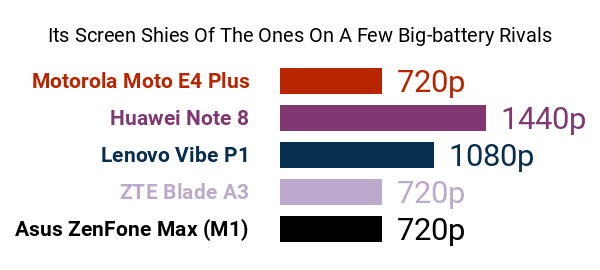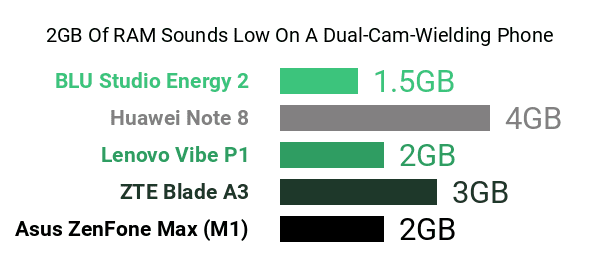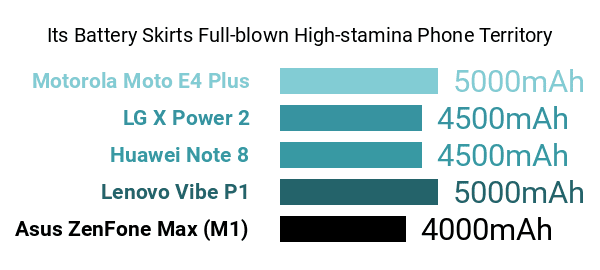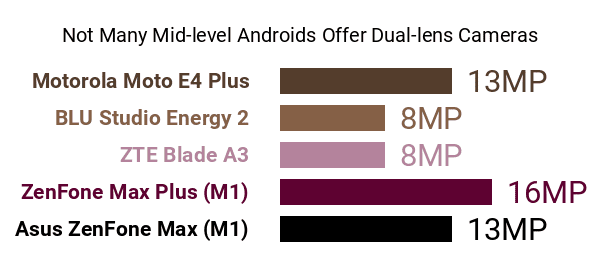- Analysis by KJ David
Officially announced during the MWC 2018, the Asus ZenFone Max (M1) has a particular inclination to endurance, a pro that it shares with most of Asus's ZenFone Max models. That being said, several of its specs fail to hit the mark, at least as far as 2018 middle-class big-battery smartphones go.
For instance, despite its wide 18:9 aspect ratio  (most other smartphones prior to its MWC 2018 debut only have 16:9 setups), its 5.5-inch IPS screen winds up as a questionable con, seeing that it settles for a meager HD+ (1440 x 720) resolution
(most other smartphones prior to its MWC 2018 debut only have 16:9 setups), its 5.5-inch IPS screen winds up as a questionable con, seeing that it settles for a meager HD+ (1440 x 720) resolution  -- some of the best phablets do not go any lower than FHD/FHD+ (1080p) definitions. Its 16GB-only internal memory
-- some of the best phablets do not go any lower than FHD/FHD+ (1080p) definitions. Its 16GB-only internal memory  sounds lackluster as well, knowing that many tantamount smartphones start off with 32GB of on-board memory. It does support up to 256GB of external space
sounds lackluster as well, knowing that many tantamount smartphones start off with 32GB of on-board memory. It does support up to 256GB of external space  , though.
, though.

We also found its 1.4GHz quad-core Snapdragon 425 processor  underwhelming, given the fact that octa-core smartphones were all the rage around the time of its market entry. Moreover, it offers no more than 2GB of RAM
underwhelming, given the fact that octa-core smartphones were all the rage around the time of its market entry. Moreover, it offers no more than 2GB of RAM  , whereas some similarly-specked models have at least 3GB at the ready.
, whereas some similarly-specked models have at least 3GB at the ready.

On the flip side, this ZenFone Max model shoots for a spot among the best phones stamina-wise, lugging a robust 4000mAh battery  under the hood. Aside from raw power, it also holds a firm footing versus most other mid-end models when it comes to battery stress test scores, boasting a 36-hour 3G talk time
under the hood. Aside from raw power, it also holds a firm footing versus most other mid-end models when it comes to battery stress test scores, boasting a 36-hour 3G talk time  and a 41-day (984 hours) 4G standby time
and a 41-day (984 hours) 4G standby time  -- both of which were more than double the corresponding averages as of this review of its technical pros and cons. It also comes with ASUS PowerMaster
-- both of which were more than double the corresponding averages as of this review of its technical pros and cons. It also comes with ASUS PowerMaster  , a suite of power-management technologies dedicated to optimizing overall battery performance and life span.
, a suite of power-management technologies dedicated to optimizing overall battery performance and life span.

The ZenFone Max (M1) apparently paid close attention to imaging as well, featuring a dual rear camera  that reminds us of the cameras rocked by some of the best phones for photography . Its dual-lens system is composed of a 13-megapixel main PixelMaster camera and an 8-megapixel wide-angle (120 degrees) secondary cam, the latter largely used for wide landscape shots or groupfies. Sadly, its list of pros and cons is marred by a humdrum 8-megapixel f/2.2 selfie camera
that reminds us of the cameras rocked by some of the best phones for photography . Its dual-lens system is composed of a 13-megapixel main PixelMaster camera and an 8-megapixel wide-angle (120 degrees) secondary cam, the latter largely used for wide landscape shots or groupfies. Sadly, its list of pros and cons is marred by a humdrum 8-megapixel f/2.2 selfie camera  , but its rear-facing dual cam sounds like a solid selling point nonetheless.
, but its rear-facing dual cam sounds like a solid selling point nonetheless.

Also joining in is its combination of a rear-mounted fingerprint sensor and a facial identification system  , with the Android 8.0 Oreo overlaid with Zen UI v5.0 tying everything together. To rehash, the Asus ZenFone Max M1 is a mid-level 5.5-incher that trades off a respectable processor for a generous battery and a dual camera system.
, with the Android 8.0 Oreo overlaid with Zen UI v5.0 tying everything together. To rehash, the Asus ZenFone Max M1 is a mid-level 5.5-incher that trades off a respectable processor for a generous battery and a dual camera system.
** This phone is also known as: Asus Max M1, Asus ZB555KL





You Should Also Check These Out:
- Confused? Let Us Find Your Perfect Phone With Celliminator
- Best Phones As Of April 2024 (12 Categories)
- Newest ASUS Phones 2024 (Latest Models)
 Full Menu
Full Menu